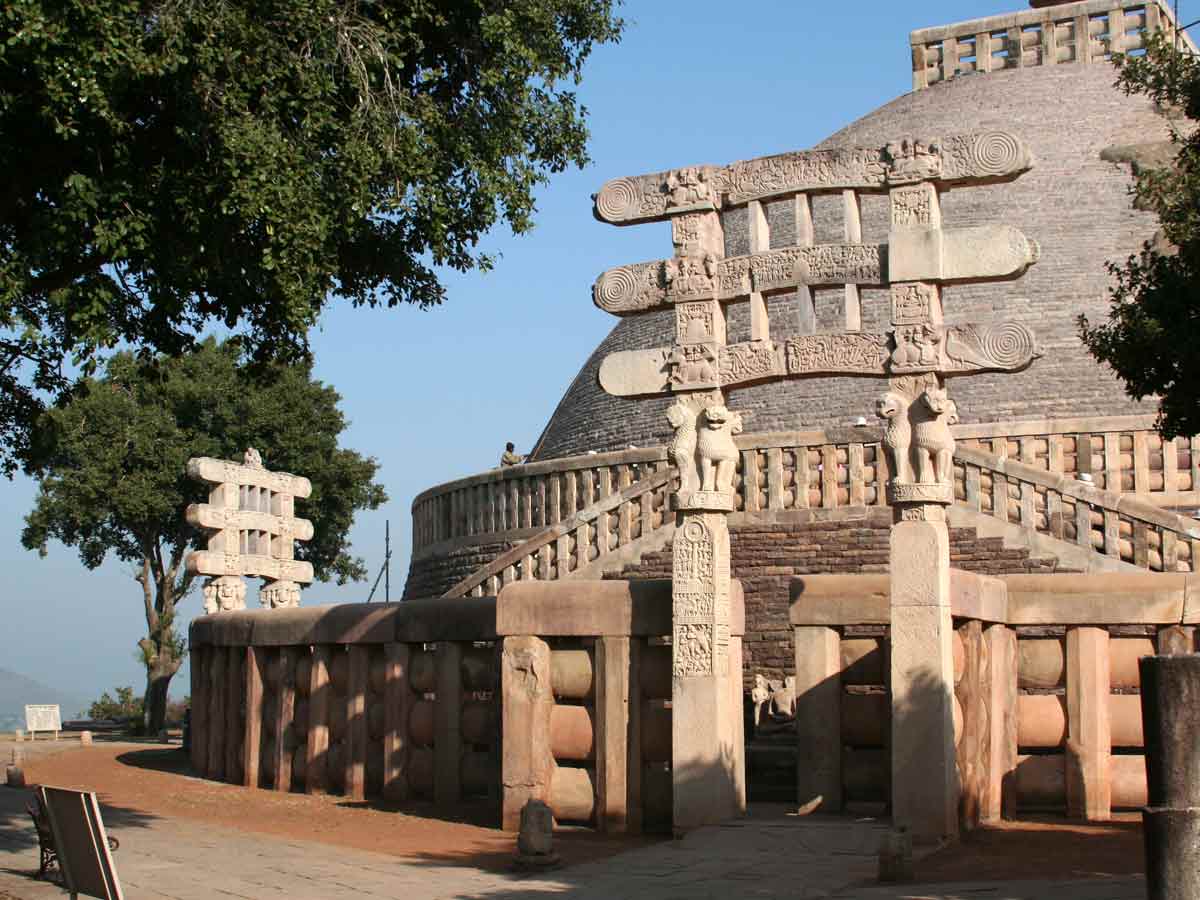Sanchi, in Madhya Pradesh, is one of the most popular tourist destinations in India. Sanchi is famous for its Stupas, which are steeped in amazing architecture. Sanchi’s Grand Stupa was commissioned by Emperor Ashok, the monarch who had stamped his mark on the entire country, and was designated as a UNESCO World Heritage site in 1989. The stupas and other monuments are the main attractions in Sanchi. For those planning a trip to Sanchi, we’ve included a travel guide below.

HOW TO REACH SANCHI
Sanchi has an excellent road network but no viable rail or air connections to the country’s major cities. Visitors to Sanchi should first travel to Bhopal, the state capital, and then to Sanchi, which is only 46 kilometers away. However, here are some of the ways that can be an option to reach Sanchi.
By Road- Sanchi is well-connected by road to Bhopal, which is 46 kilometers away, as well as Vidisha and Indore. Vidisha is only 10 kilometers away, while Indore is 232 kilometers away.
By Rail- Sanchi lacks its own railway station. Visitors should take a train to Bhopal, which has excellent rail connections across the country. From Bhopal, a taxi can be easily taken to Sanchi.
By Air- Sanchi does not have an airport of its own. However, airports in the vicinity of Sanchi include Bhopal, Jabalpur, Indore, and Khajuraho. The best option for a visitor is to fly to Bhopal and then take a taxi to Sanchi.

WEATHER OF SANCHI
Sanchi’s climate is typical of a subtropical region. Summers are hot and humid, while monsoons are wet but beautiful. Winter is both cold and wonderful. Winter is the most appealing season for visitors.
Summer (April-June)- Summer in Sanchi is humid and hot. During the four months, the maximum temperature may reach 45°C, while the minimum temperature typically falls to around 25°C, summer visits to Sanchi are not recommended. If this is unavoidable, wear light cotton clothing, drink plenty of water, and avoid the sun as much as possible.
Also Read, Bikaner: Your Ideal Travel Destination to End 2021
Monsoon (July-September)- During the rainy season, it does not rain very heavily in Sanchi. Only drizzles are expected in most cases. It is unusual for a drizzle to turn into a heavy shower. However, Sanchi transforms as the first rains fall. The entire landscape transforms into a lush green wonderland. The only issue is that during the monsoon season, Sanchi is prone to landslides. As a result, during the monsoon season, visitors are advised to avoid Sanchi.
Winter (October-March)- Sanchi’s winter is simply breathtaking. The average nighttime temperature is around 10°C or lower. The days are also the most comfortable, with the maximum temperature never exceeding 22°C. During the winter, Sanchi has several festivals. Winter visitors should try to visit Sanchi.
PLACES TO VISIT IN SANCHI
The Great Stupa

When you think of Sanchi, stupas automatically come to mind. The stupas on this site are magnificent examples of past architectural excellence. Emperor Ashoka built Sanchi’s first stupa, the Great Stupa, in the third century BC. The stupa’s exquisite carvings are a testament to the skill that went into its construction. The Great Stupa is perched on a 300-foot-high hill. From a distance, the 71-foot-tall stupa appears magnificent. Visiting Great Stupa would be a lovely way to start your tour of Sanchi; you’d feel as if you were going back in time.
Udayagiri Caves

Viewing the works of the past could not be more interesting. Historic monuments, whether they have withstood the test of time or are in ruins, always catch the eye. They not only allow you to peer into the past, but they also allow your imagination to run wild as you walk down the path walked by angels and devils, victorious and defeated, magnanimous and cruel historical figures. The Udayagiri Caves, a collection of 20 caves, provide an intriguing look into the past.
The caves contain Gupta-era sculptural representations of Hinduism and Jainism. The caves date from the fourth to fifth centuries AD. Some caves are at the top of the hill, while the majority are at the bottom. The biggest draw is the giant Narasimha sculpture.
Ashoka Pillar

Emperor Ashoka’s life has many lessons for power brokers. Such examples are rare in history when an emperor as powerful as Ashoka chose to walk in the footsteps of angels by declaring an end to the war to conquer the land. By erecting pillars throughout his kingdom, he had made his point loud and clear. The height of pillars ranged from 40 to 50 feet. The famous Ashoka Pillar from third century BC can be found near the southern gateway of Sanchi Stupa.
The pillar is a symbol of elegance, creativity, and beautiful architecture. The 16.4-meter-tall pillar with Four Lions, built-in Greco Buddhist style, has been given a stunning polish, allowing it to shine brightly to this day.
Sanchi Stupa
The Sanchi Museum is the best place to learn about the area’s history. Excavated objects dating back more than 2000 years are housed in the museum. Because it houses an impressive collection of antiques from various dynasties, you can learn more about lifestyles of people from various cultures.
Gupta Temple

The Gupta Temple in Sanchi, built in the 5th century AD, is evidence of the Gupta period’s architectural excellence. It also reflects the unity that existed among people of different faiths because the temple was built in a land that was primarily a Buddhist pilgrimage site. Sir John Marshall was so enamored with the temple’s structural beauty that he thought it was one of the most logical designs. Sanchi’s temple is a must-see.




























